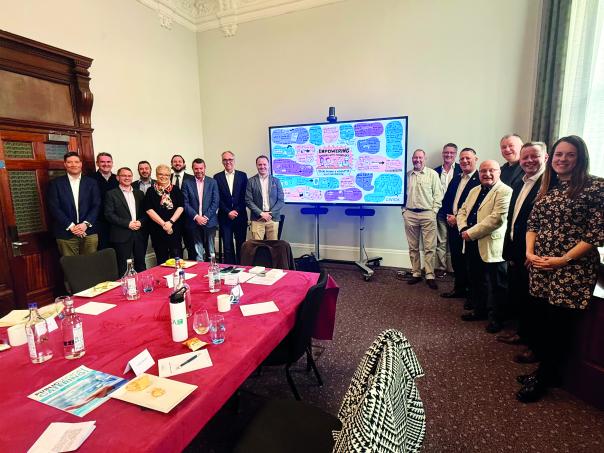
Stewart Mcluskey, Civica executive director for education, set the scene for the discussion, saying: “We’re never more than one day away from national newspaper headlines about something happening with allergens that all of us would love to avoid.
“And expectations are high, in terms of the nutrition of what people are eating, the provenance of what they’re eating, and the environmental impact of what they’re eating.
“And people can see all manner of things that they want to have access to, and the kind of catering that we will do.
“However, I think the core purpose of what you do remains - feeding healthy, nutritious meals to millions every day. And the more I talk with our public sector clients in schools and hospitals, the more I’m convinced that what you serve may well be the best meal they eat that day.
“And you need to achieve this sustainably and using a resilient business model that works for the long term.
“We work with many of the largest and most innovative food providers, both contract caterers and public sector providers, and we see every day the drive for efficiency to meet the price points you’ve been set and the desire to serve great, healthy, nutritious meals and protect the people that you feed from the risks such as allergens.”
How digital tools mitigate risk
Beyond the daily task of feeding hundreds of thousands in schools and hospitals, catering teams have responsibility for managing risk – from life-threatening allergens to stringent health and safety regulations.
The roundtable heard that many still rely on manual, paper-based systems that leave them lagging behind their contract catering counterparts in leveraging the power of technology.
Alistair Dales, managing director for education with ISS, said: “The traditional paper trail for allergy information, from parent to kitchen, is fraught with potential for error. The need for a streamlined, digital approach is paramount, not only for efficiency but for the safety of pupils.”
It is an area where technology offers the prospect of identifying a child with an allergy at the point of service, a challenge currently navigated with often imperfect solutions like wristbands.
However, the path to digital integration isn’t always smooth. Data protection, particularly GDPR, presents a significant hurdle.
As Stewart Mcluskey of Civica pointed out, healthcare has experienced this firsthand, with information governance teams often reluctant to share patient records with external technology providers.
He said this results in hybrid systems, still reliant on manual data input, which negates some of the benefits of automation.
Glenn Campbell, a consultant with Cohesion, said that in the education sector there was increasing use of biometric technology like fingerprint recognition in secondary schools.
“While initial concerns around data privacy have largely been overcome, this technology offers a robust solution to accurately identify students with allergies at the till, preventing potentially catastrophic errors.”
Facial recognition is another emerging technology, though the roundtable heard that from experience parents often feel more comfortable with fingerprint data.
He added: “The crucial advantage of biometrics is its ability to prevent students from intentionally swapping identification methods, a scenario all too real.”
Judith Gregory said the implementation of universal primary school meals in Wales had further amplified the need for technological solutions for allergen management, highlighting the significant increase in reported allergies.
“This places immense pressure on kitchen managers who are primarily cooks, not allergy specialists.”
In some cases local authorities have directly employed dietitians to support catering teams, but the roundtable heard that technology offers a scalable and efficient way to manage this complex data.
Technology is playing a crucial role in other areas of risk management, said Julian Fris of consultancy Neller Davies, who is involved in procurement for NHS trusts.
“I see the potential for digital systems to improve service, reduce waste, and offer patients more choice. While firewalls and information governance concerns can create roadblocks, the strategic implementation of technology is vital.
“And food waste is another area where technology is making a tangible difference. The NHS now mandates waste recording and digital tools are evolving to simplify this process, allowing for easier identification of problem areas and ultimately reducing environmental impact and costs.”
But the successful adoption of technology hinges on effective training and Stewart Mcluskey emphasised the importance of short, easily digestible video tutorials delivered via learning management systems.
“Given the high staff turnover in catering, continuous training is essential to ensure that teams can confidently and accurately use new digital tools,” he said.
The roundtable concluded that the digital revolution in catering is not simply a trend, but a necessity for a safer and more efficient future.
Key roundtable takeaways
1.
Risk Management and Food Safety
Tools like fingerprint and facial recognition help identify individuals with dietary restrictions, reducing the risk of errors, but manual processes still dominate in some areas and kitchen staff often have insufficient training or support.
2. Operational Efficiency and Profitability
Automated systems and pre-order tools are effective, especially in environments with tight turnaround times (eg. schools and hospital wards).
3. Data Use and Management
Data collection and accuracy are crucial to future funding claims, efficiency tracking, and meal planning, but integration between systems is lacking.
4. Training and Staff Turnover
High staff turnover requires constant retraining, so technology solutions must be simple and accessible.
5. Policy, Funding and Stakeholder Collaboration
Government policies, such as universal free school meals, have a big impact on the adoption and funding of technology solutions.
6. Future Technologies and Innovation
From automating menu planning to predicting demand and reducing waste, the possibilities are vast, but cost-effectiveness, data privacy, and ease of integration are challenges.